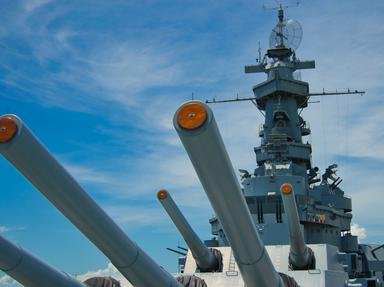Quiz Answer Key and Fun Facts
1. Which modern destroyer (Fubuki-class) built in the interwar period is the only one that sank before World War Two?
2. Akagi and Kaga are sister ships.
3. Kaga wasn't originally planned to be converted to an aircraft carrier. Akagi was originally accompanied by a sister ship to be rebuilt until an earthquake damaged her hull. What was this ship's name?
4. What was the first Japanese surface warship sunk in World War Two?
5. Following the Battle of Java Sea, Commander Shunsaku Kudo was noted for saving over 400 British and American sailors from their wrecks. From what ship did he rescue their enemies?
6. This Japanese destroyer inadvertently helped the Americans at the Battle of Midway by leading American bombers to the Japanese Fleet.
7. How many bombs did it take to sink Akagi during the Battle of Midway?
8. Which of these cruisers did NOT take part during the Battle of Savo Island?
9. This ship is known for charging head-on into an American Gauntlet during the First Naval Battle of Guadalcanal and reportedly destroying two destroyers and heavily damaging an enemy cruiser alone. Which ship is this?
10. Battleship Hiei lost a head-to-head fight versus other battleships at Guadalcanal.
11. This battle saw the Japanese attempting to reinforce the namesake island by night, and saw the sinking of a Japanese light cruiser in exchange for the heavy damage of three Allied light cruisers.
12. This carrier, considered unlucky due to the fact of almost always being damaged in every carrier engagement she participated in, was finally sunk by USS Cavalla during the Battle of the Philippine Sea.
13. During the Ambush in the Palawan Passage shortly before the Battle of Leyte Gulf, only one of four Takao-class Cruisers was able to continue with the main fleet. Which ship was it?
14. Destroyer Nowaki was sunk by air attack with all hands including the survivors from a ship sunk in the Battle off Samar. Which ship was this?
15. The experimental destroyer Shimakaze was sunk during which battle?
16. This Japanese cruiser known as "the Ship of Nine Lives" after defying sinking nearly five times in one month before finally being sunk in shallow water.
17. Submarine USS Sealion became the last submarine in history to sink a battleship. Which Japanese ship was it?
18. Japan was known to have four lucky destroyers, but one of them sank before the war ended. Which ship was this?
19. Which Agano-class light cruiser was sunk escorting battleship Yamato on her last mission (Operation Ten Ichi-go) on April 7, 1945?
20. This is the only Japanese battleship to survive the war without sinking.
Source: Author
Panzer_V
This quiz was reviewed by FunTrivia editor
bloomsby before going online.
Any errors found in FunTrivia content are routinely corrected through our feedback system.
